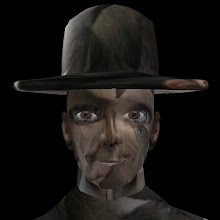Today was the first official day of the main part of the second art & design pilot.
Just a quick update on what's happened leading up to today's project launch: I started off by taking about 100 first year Graphic Arts & Design undergraduates through a half-hour OpenSim workshop as one of their inductions in the first 15 credit point introductory module a couple of weeks ago. The Manual, which is a collection of mini-projects, was issued as part of this module to get students working, and I created a post induction hand-out in a similar vein to take interested students through the first few hours in Second Life. About 7 students completed the tasks on this handout in their own time. The second module started today, with the theme of community (which is handy, considering the collaborative ambitions we have for the second pilot). 5 projects, including mine, are being run in parallel over the next 3 weeks, and students have signed up to the one they liked the look of. The other available projects are: workshop based photography, illustration activities, fanzine production, and setting up a stall in Leeds Market to sell art. I limited the places on the Second Life project to 10 participants, which I subsequently split into two teams.
The project kicked off today with all 9 (one didn't show, which was a bit annoying) participants in the real life computer room. Although one of the principals that emerged from the first pilot was that 'collaboration benefits from distance', I needed to make sure that all the students were up to speed, and this is much easier in a blended learning setting. We experienced the same confusion over real verses virtual, but I see this as a necessary evil to get things running smoothly before committing totally to the distance mode. It turns out that 3 of the participants hadn't yet signed up to Second Life, so I let the others play for a bit whilst these three latecomers zipped through Help island before joined the rest of the group on the steps of H-Building. It will be interesting to see how jumping from the OpenSim induction straight to today's project launch without completing the tasks on the handout affects the experience of these students.
I've set up two groups on the course ePortfolio tool to provide each team with a web-based tool to bring together their snapshots, have asynchronous discussions and send group messages. This fits with the idea of using third party tools to support collaboration. Each team has been allocated a generous plot of land on LeedsMet island to build all of their stuff on over the next three weeks. In the first pilot, we gave each student individual plots, which probably discouraged collaboration, so it will be interesting to see how each team gets on sharing land. The activities over the next three weeks, as mentioned in previous posts, will come from the 75 mini-tasks in 'The Manual - Second Life edition', which is displayed in the centre of LeedsMet island. Most of these mini-projects have a collaborative slant, but there are plenty of opportunities for individual effort within the set tasks.
One of the other key points that came out of the first pilot was 'Socialisation before collaboration', so the focus of today's activities was very much on the students getting to know each other. After the customary friend making ritual (which I limited to making friends within teams), Kisa was on hand to drop everyone a notecard with a bunch of landmarks to interesting locations on the mainland. We decided to all visit Svarga first, as this is a good example of what it is possible to build in Second Life. Everyone flew about on the new 'giant wasp' guided tours, and then we all teleported back to LeedsMet. After separating the two groups back into their respective teams, I asked each team to discuss where they were going to visit next out of the collection of landmarks on the notecard. They all seemed to tackle this task without too much anxiety, and without feeling the need to talk about it in real life. A couple of quick tours later, and clutching team snapshots, the students returned to their homes on LeedsMet. The last thing I did was check that everyone could build on LeedsMet, and we arranged to meet up tomorrow in-world at 10am for 'The Manual' inspired building fun.
This second pilot feels quite different to the first one. The fact that I am running this as an official project within a bigger module, running alongside other projects, and with assessable outcomes, makes it all feel a lot more real. The first pilot was a lot more experimental, with more time devoted to the induction phases, and a lot more staff around to get things going. This pilot is running within the resourcing constraints of a typical undergraduate provision, with less staff time and technical support, with the added complication of having to fit into a busy first year schedule. It is real learning in virtual environments happening on a real course at a real University. As a new course leader, virtual worlds need to prove themselves worthy of the limited resources I have available to indulge new-fangled technologies. I find myself in the unusual position of both championing virtual worlds, and simultaneously demanding evidence that they are worth the money. If this project proves to be clearly beneficial to first year graphics students, then I will run it every year. If I think that these students would have been better off spending their time selling pictures in the market, then I will axe it. Oh, my own harshest critic. What fun.
Monday, 20 October 2008
Subscribe to:
Post Comments (Atom)

No comments:
Post a Comment